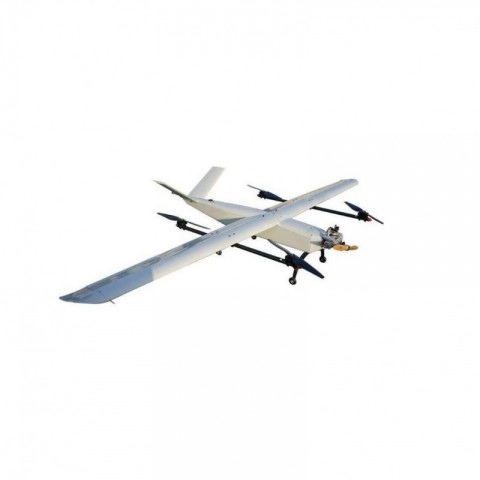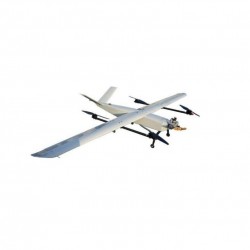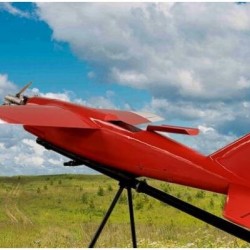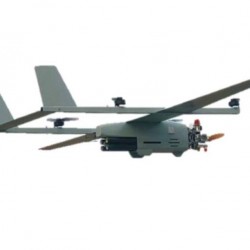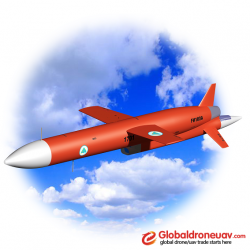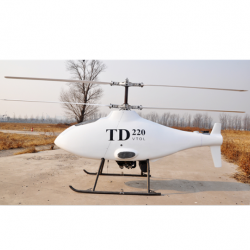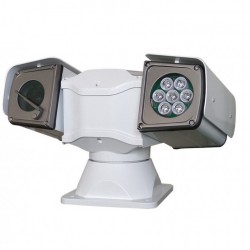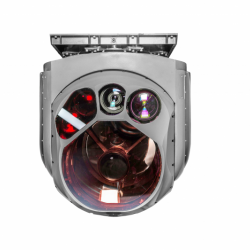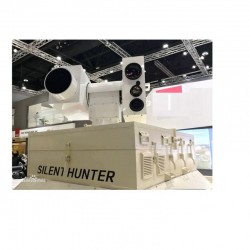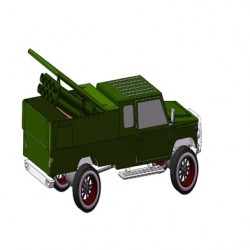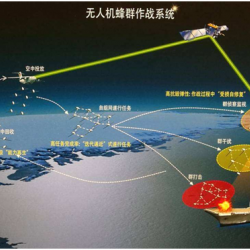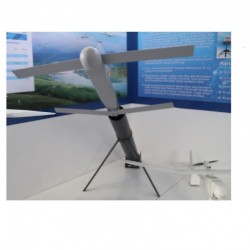1 Overview
HW-V210A Unmanned Aerial Vehicle (UAV) as a Vertical Takeoff and Landing (VTOL) UAV flying platform boasts features of both fixed-wing planes and multi-rotor aircrafts, that is, long endurance and large control radius of the former and easy takeoff and landing and low requirements for sites of the latter. Integrated with multiple payloads, HW-V210A UAV can complete HD video capture and real-time back-transmitting tasks. It has been widely used in many areas including danger detection, technical investigation, border patrolling, search and rescue, manhunt, pavement monitoring and earthquake relief, and solved many problems of ordinary fixed-wing planes such as difficulty in takeoff and landing and complicated takeoff and landing operations resulting from terrain restrictions including in forests, in mountains, and on board.
2 System Components and Technical Indicators
HW-V210A hybrid VTOL UAV mainly consists of the aircraft platform subsystem, load subsystem, measurement, control and information transmission subsystem and ground support subsystem. See Figure 1 for the system chart.
2.1 Main technical indicators of the system
1) Cruising speed: 80-110km/h;
2) Endurance: ≥4h (2kg load);
3) Service ceiling: ≥3500m;
4) Wind resistance rating: 5;
5) Maximum payload: 5kg;
6) Maximum takeoff weight: 27.5kg;
7) Unfolding configuration time: ≯20min.
2.2 Aircraft platform subsystem
The aircraft platform adopts the VTOL inverted V-shaped tail configuration. Two rotor support arms are distributed evenly under the wings on both sides. The following figure shows the outline of the aircraft platform.

2.2.1 Main outline parameters
➢ Wing span: 3.6m;
➢ Aircraft length: 2.0m;
➢ Aircraft height: 0.3m.
2.2.2 Body structure
The UAV structure mainly adopts the carbon fiber/GFRP honeycomb sandwich design, featuring high strength, impact resistance and easy maintenance. It is the mainstream composite material used for light UAVs currently.
The fuselage is made of carbon fiber, with three GFRP hatch covers set on the upper part from front to back for the convenience of equipment assembly and maintenance. The belly is installed with a carbon fiber landing gear which is used as a damping device for take-off and landing. The fuselage is designed with battery mounting plate and flight control equipment mounting plate inside, for the convenience of equipment fixing and gravity center adjusting.
The wing is made of honeycomb sandwiches, and connected to the fuselage through three carbon fiber beams passing through the fuselage. Also, tails are supported by carbon fiber beams. Rotor support arms are carbon fiber tubes, fixed to metal parts under the wing through bolts. Two ends are designed with metal motor bases for fixing rotor motors.
After disassembly, components are put in a customized light transport case, enhancing the convenience and safety of transportation.
Figure 3 shows the main equipment layout of UAV.
 2.2.3 Control system
2.2.3 Control systemHW-V210A UAV can have rotary-wing and fixed-wing flying modes at the same time. Its flight control and navigation equipment mainly has the following features:
➢ Intelligent flight control mode: Support precise VTOL control and landing in other places, enable free switch between flight control modes including full-autonomous mode, stability augmentation mode and remote control mode through the ground monitoring station, and allow autonomous operation of UAV in the whole process;
➢ High-precision motion measurement: Measure the location, speed and flying attitude of UAV during flying;
➢ High-integration design: High integration, small volume and low power consumption;
➢ Harsh environment adaptability and reliability: Work steadily under the temperature between -40℃ and 60℃ and humidity of 95%;
➢ Completion emergency treatment: Allow normal hovering and landing in the absence of GPS signal to ensure flight safety to the upmost extent.
The flight control and navigation equipment consists of automatic pilot, data link antenna, airborne GPS antenna and so on. GPS antenna and data link antenna are installed on the top surface of the fuselage, which helps signal transmitting and receiving; automatic pilot and magnetic compass are installed in the rear cabin for the convenience of cable routing; pilot tube is set before the right winglet to ensure correct airspeed measurement.
2.2.4 Power system
The UAV power system consists of two parts: rotary wing power system and fixed wing power system. The former provides lifting force for the UAV during VTOL and the latter provides pulling force during cruising.
3.2.3.1 Rotary wing power system
Rotary wing power system consists of four groups of disc-type motors, screw propellers and electronic speed controller. Four groups of disc-type motors and screw propellers are respectively installed on four motor bases at two ends of the support arm. The electronic speed controller is set on the bottom surface close to the fuselage, with heating panel extruding from the base which helps heat dissipation.
3.2.3.2 Fixed wing power system
Fixed wing power system consists of the engine, screw propeller, fuel tank, fuel pump, fuel lines, electric starter, ECU and so on. The propeller is installed with a cover for rectification and protection. The engine and propeller are installed on the specially-made engine mounting base which can fence out most of engine vibration. The outline of engine is shown in Figure 4.
 2.3 Load subsystem
2.3 Load subsystemPhotoelectric pod and other loads can be carried according to task needs. Photoelectric pod consists of the two-axis stabilization platform, visible light camera, image tracker, and so on.
Photoelectric pod has the following features:
➢ Provide HD visible video images;
➢ Search for and monitor targets on the ground, sea and in the sky;
➢ Stabilize the visual axis on the motion carrier;
➢ Allow manual control of the aiming line movement, locate the target and track it automatically;
➢ Output the status information of the subsystem through the communication interface;
Indicators of photoelectric pod are provided as below:
1) Stabilization platform
◆ Type: Two-axis stabilization;
◆ Or ientation range: 360*n°, Pitch range: -120º~+90º;
◆ Stabilization accuracy: ≤0.2mrad (1σ);
2) Visible light camera
◆ Resolution: 1920 * 1080 (HD);
◆ Working waveband: 0.4~0.9μm;
◆ Optical zoom: 30x;
◆ Detection distance: 4km (3m*4m target);
◆ Identification distance: 2km (3m*4m target);
3) Un-cooled infrared sensor
◆ Resolution: 640*480;
◆ Pixel size: 17μm;
◆ Detector material: Vanadium oxide
2.4 Measurement, control and information transmission subsystem
The measurement, control and information transmission subsystem has the designed operating distance of 20km. It can achieve information transmission between the UAV and ground, and has the following main functions:
Flight control system remote control/telemetry: The flight control system uses the function to send telemetry information to the ground control station, and the ground control station uses the function to send remote control commands to the flight control system;
Image transmission: UAV uses the function to send the image information obtained by the load system to the ground control console, and the image information is recorded by and displayed in the ground control console in real time.
Photoelectric pod remote control and telemetry: The function is used to transmit remote control and telemetry information between the photoelectric pod and ground control console.
2.5 Comprehensive support subsystem
The aircraft transport case can accommodate a VTOL UAV body safely. It can ensure the safety of UAV during Level 1-4 road transportation and air consignment, with the protection grade of IP54. The aircraft transport case has a wooden body with aluminum alloy wrapped edges and foam separation layers inside. The case size is controlled to be smaller than 400×500×2000mm and the weight is controlled to be less than 20kg.
3 Environment Conditions of Use and Storage
4 Typical Operating Procedures of UAV
With the execution of reconnaissance mission as an example, Figure 5 shows the typical operating procedures of HW-V210A UAV, including: flight plan formulation, preflight technical preparation, task execution, recovery and maintenance. After maintenance, UAV can be used to execute tasks again.(1) Upload the UAV, ground control station and other devices on the transporter. The transporter moves to the proper place according to task requirements.
(2) Unpack and assemble the UAV, refuel it, unfold ground control station devices and formulate task plans.
(3) Carry out online ground self-testing of the UAV through the ground control station. When everything has been tested to be normal, carry out pre-takeoff check.
(4) After the truck-mounted take-off, the ground control station monitors UAV working parameters, flight track and image information transmitted from the load.
( (5 ) After the UAV flies to the designated air position, execute the tasks of reconnaissance, monitoring and target positioning, start the reconnaissance equipment to search for the target, and send the video to the ground control station for real-time display. When the target is found, the ground control station sends out a track command and the target will be tracked automatically.
(6) After the UAV landing and recovery, routine checking and corresponding maintenance are carried out.
Figure 5 Typical Operating Procedures of HW-V210A UAV
5 Support and Service
5.1.1 On-site support
Technical support on the flying site refers to ground equipment self-testing, status checking before takeoff and on-site simple maintenance for body structure of recovered UAV, including replacement of equipment accessories and wear parts, and other simple maintenance operations. Actual execution will be in accordance with contract regulations.
5.1.2 base guarantee
Status checking and maintenance are carried out once every year for all UAV systems, which will be put in packing cases for storage after checking. base-level maintenance is carried out by professional maintenance personnel. Actual execution will be in accordance with contract regulations.
5.2 After-sales service
It should be carried out in accordance with the provisions in the contract.
5.3 Training and materials
It should be carried out in accordance with the provisions in the contract.
6 Attachment: Equipment Configuration List
Table 3 Equipment Configuration List

 1) Cruising speed: 80-110km/h;
1) Cruising speed: 80-110km/h;2) Endurance: ≥4h (2kg load);
3) Service ceiling: ≥3500m;
4) Wind resistance rating: 5;
5) Maximum payload: 5kg;
6) Maximum takeoff weight: 27.5kg;
7) Unfolding configuration time: ≯20min.
